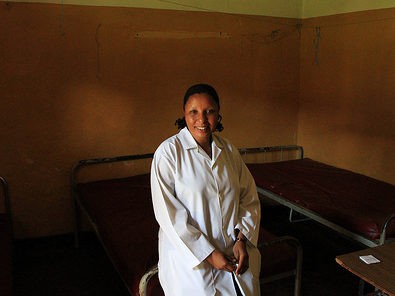NEPI
The Nurse Education Partnership InitiativeImpact
The Need
Critical shortages of health care workers exist throughout much of sub-Saharan Africa. In 2006, the World Health Organization reported that the region accounted for 3 percent of the world’s total health workforce despite being home to 25 percent of the global disease burden.
Nurses and midwives are the gateway to health care in most communities and provide 90 percent of care in many African countries. In areas with a shortage of physicians, nurses have helped increase access to lifesaving care, including antiretroviral treatment for HIV. Despite practicing with an expanded scope of services, nurses are often unprepared and under-trained for the clinical realities they face.

Long-standing underinvestment in pre-service nursing and midwifery education has limited the capacity of many African nursing education institutions and clinical services to educate nurses and midwives in sufficient numbers and with the appropriate clinical skills to meet current and anticipated population-level health needs.
Competent, well-trained, and skilled nurses improve health care quality for all. Sustainable health care systems depend on building the capacity of nurses and midwives to meet the demands of the people they serve.
Nursing Needs in NEPI Focus Countries
Lesotho
Lesotho has the third highest prevalence of HIV/AIDS in the world, at 23% of the adult population.The ratio of nurses and midwives in Lesotho has decreased from 1.07 per 1,000 people in the mid-1990s to 0.49 per 1,000 in 2011, significantly affecting the country’s ability to meet the complex health needs of its population.
Malawi
Nurses and midwives constitute 87% of the health workforce in Malawi, often serving as the sole health provider in rural settings. The vacancy rate for nursing and midwifery positions in the public sector is 65%. Lacking adequate training, many nurses and midwives are ill equipped to function optimally as the sole service provider.
Zambia
Nurses and midwives constitute 63% of Zambia’s healthcare workforce and are the highest skilled clinical worker in almost half the country’s public health facilities. In spite of recent growth in the nursing workforce, Zambia is currently operating at 47% of its nurse/midwife target, with an anticipated nurse/midwife gap of 20% by 2020.
Ethiopia
Constituting 32% of Ethiopia’s health workforce, nurses and midwives are the second largest category of health workers in the country. The country’s nurses and midwives are unequally distributed between urban and rural areas, with a density of 1.6 nurses per 1,000 people in urban areas and 0.3 per 1,000 in rural areas.
Democratic Republic of Congo
DRC is experiencing a critical shortage of health care workers and has made few gains in reducing child mortality or new HIVinfections. Nurses and midwives constitute 55% of the country’s health workforce, with a density of 0.59 per 1,000 people.
South Africa
Nurses and midwives are the largest group of health care workers in South Africa, significantly outnumbering physicians. However, there is a lack of retention of health graduates in the country’s public health sector and high attrition from key health professions.
Key Achievements
Innovations in Curriculum Development
Malawi
Through NEPI’s support, the Kamuzu College of Nursing developed a curriculum for a PhD in Inter-professional Health Care Leadership. The degree program is the first of its kind in the country, as well as the first in nursing and health sciences on the continent. The University implemented the curriculum in March 2014 with seven candidates.
Zambia
NEPI, in collaboration with the General Nurses Council of Zambia, the Ministry of Health, the Lusaka Schools of Nursing and Midwifery, and the Monze School, implemented a new combined registered nurse-midwife curriculum. The new curriculum successfully reduced the amount of time to produce comprehensively trained registered nurses from six years to three-and-a-half years.
The initiative’s success has led to expansion of the program to three schools. It is expected that the curriculum will cut costs for the government and increase the availability of comprehensively trained nurses to manage maternal and child health needs.
Tuition Support for Increased Enrollment & Capacity Building Opportunities for Faculty
Zambia
Tuition support, provided through NEPI, increased nurse-tutor enrollment at the University of Zambia’s Department of Nursing Sciences by 61 percent. The Department was the only institution in the country accredited to produce nurse educators.
NEPI’s tuition support enabled six of the Department’s nursing faculty to start master’s-level study in high-need subjects such as anatomy, physiology, and biochemistry.
Malawi
With NEPI support, the Kamuzu College of Nursing at the University of Malawi developed and implemented a Master’s in Nursing and Midwifery Education for faculty members. In addition to developing expertise in education, faculty members enrolled in the Master’s program began a clinical specialization of their choice.
The investment ensures faculty can bridge the service-academic divide, providing clinical and academic education that is relevant and up-to-date. Since the program’s implementation, post-graduate enrollments in nursing increased by 35 percent.
Improved Teaching Infrastructure and Resources for Nurse Education
Lesotho
NEPI installed and equipped clinical simulation laboratories at all six nursing education institutions in Lesotho. The goal was to increase the quality of clinical teaching by providing life-like experiential learning opportunities for students to develop required competencies, as well as contributing to the evidence-base for clinical simulation in low-resource settings.
NEPI recruited simulation laboratory coordinators to oversee the laboratory environment and resources, assist faculty in running simulations, and support students in achieving their clinical learning objectives.
Read more about NEPI’s accomplishments from 2012-2016 here.





